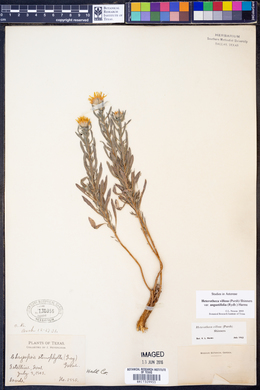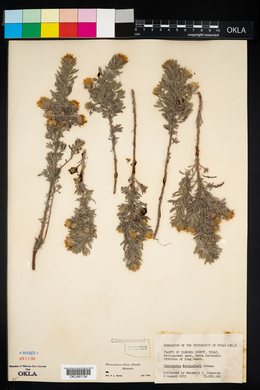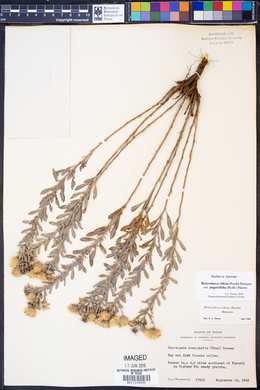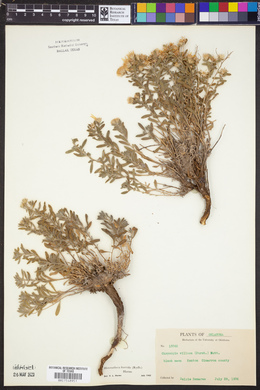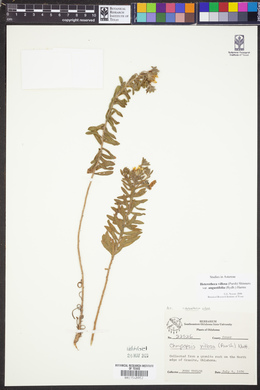|
|
|
|
Family: Asteraceae
hairy false goldenaster, more...hairy goldenaster, hairy false goldaster, hairy goldaster
|
Perennials, (5-)16-40(-70) cm; taprooted. Stems 1-50+, decumbent to erect (sometimes brown or reddish brown, sometimes whitish distally, sometimes ± brittle), sparsely to densely hispido-strigose, sparsely to abundantly long-hispid, eglandular or sparsely to densely stipitate-glandular. Leaves generally not crowded; proximal cauline petiolate, blades oblanceolate, (90-)220-400(-600) × (2-)4-8(-13) mm, bases cuneate, margins flat, usually entire, rarely with 1-2 apical teeth, strigoso-ciliate, sparsely to abundantly long-hispido-strigose proximally, apices acute to obtuse, sometimes mucronate, faces sparsely to densely hispido-strigose, eglandular or sparsely to densely stipitate-glandular; distal sessile, blades usually lanceolate or oblanceolate to oblong, rarely ovate or lanceolate-triangular, (4-)15-28(-42) × (1.5-)3.5-7(-12.5) mm, bases attenuate to convex-cuneate to rounded, margins usually flat, rarely remotely undulate, strigoso-ciliate, sparsely to abundantly long-hispido-strigose proximally, apices acute to obtuse, sometimes mucronate, faces sparsely to densely hispido-strigose, eglandular or sparsely to densely stipitate-glandular. Heads 1-16(-42), in usually open, corymbiform, rarely paniculiform arrays. Peduncles (4-)15-41(-98) mm, sparsely to densely hispido-canescent, eglandular or sparsely to densely stipitate-glandular; bracts 1-7+, usually linear-oblanceolate, rarely leaflike and linear-oblanceolate, usually greatly reduced, margins usually flat, rarely remotely undulate, strigoso-ciliate, sparsely to abundantly long-hispido-strigose proximally, apices acute, sometimes mucronate, faces sparsely to densely hispido-strigose, eglandular or sparsely to densely stipitate-glandular; rarely 1-2 leaflike, oblanceolate bracts subtending heads. Involucres narrowly cylindric to campanulate, (5-)6-9.5(-13) mm. Phyllaries in 4-5 series, lanceolate to linear-lanceolate or triangular-lancelate, unequal (outer 1 / 5 - 1 / 3 length of inner), margins scarious, sometimes reddish purple distally, ciliate distally or apically, faces sparsely to densely strigose, eglandular or sparsely to moderately stipitate-glandular. Ray florets (5-)10-20(-38); laminae (3.5-)6.5-11(-20) × 1-2(-3) mm. Disc florets (10-)20-50(-85); corollas barely ampliate, (4-)5-6(-8) mm, glabrous or glabrate (few, minute hairs), lobes 0.4-0.75(-1) mm, glabrous or glabrate (hairs 0.1-0.35 mm). Cypselae< Heterotheca villosa is variable in stem height, leaf base shape, stem and leaf indument, number of heads, and number of florets. Thus, the species is difficult to circumscribe because each variety has a suite of diagnostic traits and a distribution that is restricted to a portion of the range of the species. Generally, var. minor (glandular), and to a lesser extent, var. foliosa (eglandular) are the glue holding the other varieties together in a widely distributed polymorphic species; this is comparable to the situation in H. sessiliflora, in which var. echioides is the glue. Variety minor hybridizes with all other varieties. Numerous local races occur that are sometimes quite distinct when extreme, but they intergrade with one or more other races, especially in var. minor (J. C. Semple 1996). The species is divided here on the basis of indument features, leaf shape, and stem height, paralleling the infraspecific treatments of H. fulcrata and H. sessiliflora. H. A. Gleason and A. Cronquist (1991) and Cronquist (1994) acknowledged the variability of the species and the existence of many local races, but lumped most of these into var. villosa and var. hispida of Chrysopsis villosa, in which they also included H. camporum, H. canescens, H. fulcrata, H. pumila, H. stenophylla var. angustifolia, H. viscida, and H. zionensis. Diploid races are usually distinct from each other, but each has given rise to one or more tetraploid lines that are less distinct. The treatment here is based on the detailed presentation in Semple.
Plant: Perennial 1-13 dm, decumbent to erect, ± bristly-strigose, sometimes densely glandular above Leaves: cauline, alternate, ± (ob)lanceolate, generally flat; hairs generally < 1 mm; lower tapered to base; upper tapered to subclasping INFLORESCENCE: primary inflorescence a head, each resembling a flower; heads 1-many, radiate; ± flat-topped; involucre ± bell-shaped; phyllaries in 3-5 graded series; receptacle naked, pitted Flowers: Ray flowers 7-30; ligules 4-12 mm, yellow; Disk flowers 30-80; corollas 4-8 mm, yellow, lobes (sub)glabrous (any hairs < 0.2 mm), glands few; style branches finely papillate, appendage narrowly triangular Fruit: 2-4 mm, obconic; ray fruit ± 3-angled; disk fruit compressed, outer pappus of narrow scales < 1 mm, inner of 30-45 bristles 3-7 mm Misc: Crevices, open sand and gravel, lava flows; 400-3100 m. |
|
|
|














































